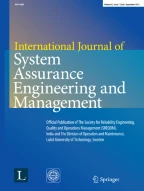Abstract
An integrated single vendor, single buyer inventory policy is incorporated in a continuous review model with stochastic demand. The production process is assumed to involve deterioration process and produces a certain number of defective items. In the real life production environment, it can often be observed that defective items are produced due to imperfect production processes. A situation in which the vendor invests money to improve the quality of the production process and thereby reduce the defective percentage is considered. 100% error-free screening process adopted by the buyer to separate the defective and non defective items is incorporated to focus on the varying inventory holding costs. Shortages are allowed and completely backlogged. In realistic circumstance, when an order is placed, the products will be delivered only after a certain period of time (lead time). But, owing to tough competition, the buyer may pay an extra amount in order to reduce the lead time. This realistic assumption is incorporated in this model. The model is formulated by allowing the lead time demand to be distributions free and follow a normal distribution. The prime motive is to determine the optimal policies regarding optimal order quantity, reorder point, lead time and the number of lots delivered in a production run by minimizing the expected total cost of the system considered.
Similar content being viewed by others
References
Annadurai K (2016) Minimax distribution-free procedure for mixture inventory model with variable lead time and a service level constraint by reducing order cost. Am J Math Manag Sci 35(1):1–14
Amasaka K (2002) “New JIT”: a new management technology principle at Toyota. Int J Prod Econ 80(2):135–144
Banerjee A (1986) A joint economic-lot-size model for purchaser and vendor. Decis Sci 17(3):292–311
Ben-Daya M, Raouf A (1994) Inventory models involving lead time as a decision variable. J Oper Res Soc 45(5):579–582
Ben-Daya M, Hariga M (2004) Integrated single vendor single buyer model with stochastic demand and variable lead time. Int J Prod Econ 92(1):75–80
Bylka S (2003) Competitive and cooperative policies for the vendor–buyer system. Int J Prod Econ 81:533–544
Dey O, Giri BC (2014) Optimal vendor investment for reducing defect rate in a vendor–buyer integrated system with imperfect production process. Int J Prod Econ 155:222–228
Gallego G, Moon I (1993) The distribution free newsboy problem: review and extensions. J Oper Res Soc 44(8):825–834
Goyal SK (1988) “A joint economic-litsize model for purchaser and vendor”: a comment. Decis Sci 19(1):236–241
Hadley G, Whitin TM (1963) Analysis of inventory systems. Prentice-Hall, Englewood Cliffs
Huang CK (2002) An integrated vendor–buyer cooperative inventory model for items with imperfect quality. Prod Plan Control 13(4):355–361
Huang CK (2004) An optimal policy for a single-vendor single-buyer integrated productioninventory problem with process unreliability consideration. Int J Prod Econ 91(1):91–98
Khan M, Jaber MY, Ahmad AR (2014) An integrated supply chain model with errors in quality inspection and learning in production. Omega 42(1):16–24
Ouyang LY, Wu KS, Ho CH (2004) Integrated vendorbuyer cooperative models with stochastic demand in controllable lead time. Int J Prod Econ 92(3):255–266
Ouyang LY, Wu KS, Ho CH (2007) An integrated vendor–buyer inventory model with quality improvement and lead time reduction. Int J Prod Econ 108(1):349–358
Lin YJ (2009) An integrated vendorbuyer inventory model with backorder price discount and effective investment to reduce ordering cost. Comput Ind Eng 56(4):1597–1606
Lin HJ (2012) An integrated supply chain inventory model with imperfect-quality items, controllable lead time and distribution-free demand. Yugoslav J Oper Res. ISSN: 0354-0243 EISSN: 2334-6043, 23(1)
Pan JCH, Yang JS (2002) A study of an integrated inventory with controllable lead time. Int J Prod Res 40(5):1263–1273
Porteus EL (1985) Investing in reduced setups in the EOQ model. Manage Sci 31(8):998–1010
Porteus EL (1986) Optimal lot sizing, process quality improvement and setup cost reduction. Oper Res 34(1):137–144
Priyan S, Uthayakumar R (2014) Trade credit financing in the vendorbuyer inventory system with ordering cost reduction, transportation cost and backorder price discount when the received quantity is uncertain. J Manuf Syst 33(4):654–674
Priyan S, Uthayakumar R (2015) Mathematical modeling and computational algorithm to solve multi-echelon multi-constraint inventory problem with errors in quality inspection. J Math Model Algor Oper Res 14(1):67–89
Priyan S, Uthayakumar R (2015) Two-echelon multi-product multi-constraint product returns inventory model with permissible delay in payments and variable lead time. J Manuf Syst 36:244–262
Scarf H, Arrow KJ, Karlin S (1958) A min−max solution of an inventory problem. Studies in the mathematical theory of inventory and production 10:201–209
Tersine RJ (1982) Principles of inventory and materials management. Elsevier, North Holland, Amsterdam
Acknowledgements
The authors are grateful to the Department of Science and Technology - Science and Engineering Research Board (DST-SERB), Government of India, New Delhi, for providing financial assistance in the form of Fellowship. This research was fully supported by DST-SERB, Government of India under the grant number DST-SERB/SR/S4/MS: 814/13-Dated 24.04.2014.
Author information
Authors and Affiliations
Corresponding author
Rights and permissions
About this article
Cite this article
Kumar, M.G., Uthayakumar, R. An integrated single vendor–buyer inventory model for imperfect production process with stochastic demand in controllable lead time. Int J Syst Assur Eng Manag 8 (Suppl 2), 1041–1054 (2017). https://doi.org/10.1007/s13198-016-0565-5
Received:
Revised:
Published:
Issue Date:
DOI: https://doi.org/10.1007/s13198-016-0565-5
